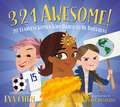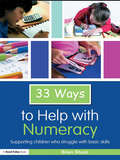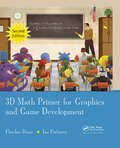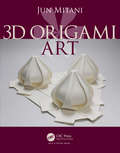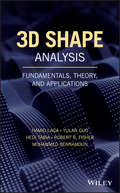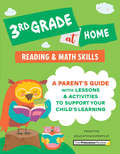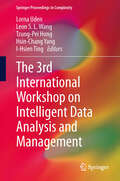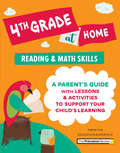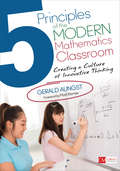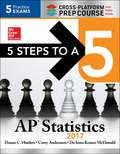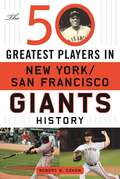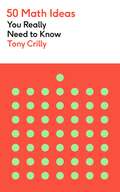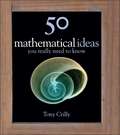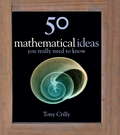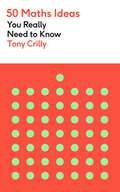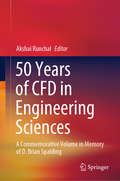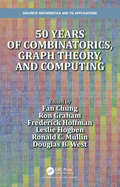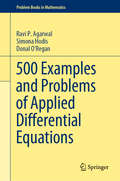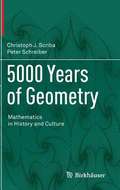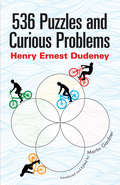- Table View
- List View
3 2 1 Awesome!: 20 Fearless Women Who Dared to Be Different
by Eva ChenInstagram superstar and New York Times bestselling author of Juno Valentine and the Magical Shoes Eva Chen shines a spotlight on 20 amazing women—including Megan Rapinoe, Sonia Sotomayor, Shirley Chisholm, Greta Thunberg and more!—in 3 2 1 Awesome! a sassy and fun counting board book, perfect for the youngest of budding feminists.Why stick to counting on fingers and toes when you can count:3 straight sets for Billie Jean King's historic win...2 groundbreaking suffragettes named Susan B. Anthony and Elizabeth Cady Stanton...1 singular, sensational YOU!With Derek Desierto's bold and vibrant art, Eva fans and readers of all ages will be transported through "herstory."
3264 AND ALL THAT: A Second Course in Algebraic Geometry
by David Eisenbud Joe HarrisThis book can form the basis of a second course in algebraic geometry. As motivation, it takes concrete questions from enumerative geometry and intersection theory, and provides intuition and technique, so that the student develops the ability to solve geometric problems. The authors explain key ideas, including rational equivalence, Chow rings, Schubert calculus and Chern classes, and readers will appreciate the abundant examples, many provided as exercises with solutions available online. Intersection is concerned with the enumeration of solutions of systems of polynomial equations in several variables. It has been an active area of mathematics since the work of Leibniz. Chasles' nineteenth-century calculation that there are 3264 smooth conic plane curves tangent to five given general conics was an important landmark, and was the inspiration behind the title of this book. Such computations were motivation for Poincaré's development of topology, and for many subsequent theories, so that intersection theory is now a central topic of modern mathematics.
33 Ways to Help with Numeracy: Supporting Children who Struggle with Basic Skills (Thirty Three Ways to Help with....)
by Brian SharpThirty Three Ways to Help with Numeracy equips teachers and teaching assistants with a wide range of practical resources to help children who are having difficulties learning the basic skills of numeracy. By providing a range of activities and games which engage children and encourage motivation in the classroom, the book provides ready-to-use exercises that don’t need lengthy forward preparation. Any materials needed are readily available in the classroom or are provided here to photocopy. The activities are designed using a range of different learning styles to: build learners’ confidence and self esteem develop reasoning and thinking about physical number situations encourage discussions explore numbers by doing The activities can be used with individual children, groups or the whole class. The introduction at the head of each activity describes precisely what it aims to teach the child, followed by clear, concise instructions on how to play each game. Teachers, SENCos and Teaching Assistants will welcome this helpful resource, which complements Thirty Three Ways to Help with Reading also available from Routledge.
3D Math Primer for Graphics and Game Development (Wordware Game Math Library)
by Fletcher Dunn Ian ParberryThis engaging book presents the essential mathematics needed to describe, simulate, and render a 3D world. Reflecting both academic and in-the-trenches practical experience, the authors teach you how to describe objects and their positions, orientations, and trajectories in 3D using mathematics. The text provides an introduction to mathematics for
3D Origami Art
by Jun MitaniEasily Create Origami with Curved Folds and Surfaces Origami—making shapes only through folding—reveals a fascinating area of geometry woven with a variety of representations. The world of origami has progressed dramatically since the advent of computer programs to perform the necessary computations for origami design. 3D Origami Art presents the design methods underlying 3D creations derived from computation. It includes numerous photos and design drawings called crease patterns, which are available for download on the author’s website. Through the book’s clear figures and descriptions, readers can easily create geometric 3D structures out of a set of lines and curves drawn on a 2D plane. The author uses various shapes of sheets such as rectangles and regular polygons, instead of square paper, to create the origami. Many of the origami creations have a 3D structure composed of curved surfaces, and some of them have complicated forms. However, the background theory underlying all the creations is very simple. The author shows how different origami forms are designed from a common theory.
3D Shape Analysis: Fundamentals, Theory, and Applications
by Mohammed Bennamoun Robert B. Fisher Hedi Tabia Yulan Guo Hamid LagaAn in-depth description of the state-of-the-art of 3D shape analysis techniques and their applications This book discusses the different topics that come under the title of "3D shape analysis". It covers the theoretical foundations and the major solutions that have been presented in the literature. It also establishes links between solutions proposed by different communities that studied 3D shape, such as mathematics and statistics, medical imaging, computer vision, and computer graphics. The first part of 3D Shape Analysis: Fundamentals, Theory, and Applications provides a review of the background concepts such as methods for the acquisition and representation of 3D geometries, and the fundamentals of geometry and topology. It specifically covers stereo matching, structured light, and intrinsic vs. extrinsic properties of shape. Parts 2 and 3 present a range of mathematical and algorithmic tools (which are used for e.g., global descriptors, keypoint detectors, local feature descriptors, and algorithms) that are commonly used for the detection, registration, recognition, classification, and retrieval of 3D objects. Both also place strong emphasis on recent techniques motivated by the spread of commodity devices for 3D acquisition. Part 4 demonstrates the use of these techniques in a selection of 3D shape analysis applications. It covers 3D face recognition, object recognition in 3D scenes, and 3D shape retrieval. It also discusses examples of semantic applications and cross domain 3D retrieval, i.e. how to retrieve 3D models using various types of modalities, e.g. sketches and/or images. The book concludes with a summary of the main ideas and discussions of the future trends. 3D Shape Analysis: Fundamentals, Theory, and Applications is an excellent reference for graduate students, researchers, and professionals in different fields of mathematics, computer science, and engineering. It is also ideal for courses in computer vision and computer graphics, as well as for those seeking 3D industrial/commercial solutions.
3rd Grade at Home: A Parent's Guide with Lessons & Activities to Support Your Child's Learning (Math & Reading Skills) (Learn at Home)
by The Princeton ReviewLearn at home with help from the education experts at The Princeton Review! 3RD GRADE AT HOME provides simple, guided lessons and activities that parents can use to help keep 3rd graders on track this year.Anxious about remote learning and hybrid schooling? Worried that the unique circumstances around coronavirus and education might keep your child from getting the help they need in class this year? Want to help support your child's schooling, but not sure where to start?You're not alone! 3RD GRADE AT HOME is a parent guide to supporting your child's learning, with help you can undertake from home. It provides: · Guided help for key 3rd grade reading and math topics· Skills broken into short, easy-to-accomplish lessons· Explanations for parents, plus independent question sets for kids· Fun at-home learning activities for each skill that use common household items· Parent tips, review sections, and challenge activities seeded throughout the bookThe perfect mix of parent guidance, practical lessons, and hands-on activities to keep kids engaged and up-to-date, 3RD GRADE AT HOME covers key grade-appropriate topics including:· early reading comprehension · context and understanding· fiction and nonfiction· event order· problem and solution· addition and subtraction· multiplication and division· fractions and decimals· shapes, symmetry, and patterns· probability... and more!
The 3rd International Workshop on Intelligent Data Analysis and Management
by Leon S.L. Wang Tzung-Pei Hong Lorna Uden I-Hsien Ting Hsin-Chang YangThese papers on Intelligent Data Analysis and Management (IDAM) examine issues related to the research and applications of Artificial Intelligence techniques in data analysis and management across a variety of disciplines. The papers derive from the 2013 IDAM conference in Kaohsiung ,Taiwan. It is an interdisciplinary research field involving academic researchers in information technologies, computer science, public policy, bioinformatics, medical informatics, and social and behavior studies, etc. The techniques studied include (but are not limited to): data visualization, data pre-processing, data engineering, database mining techniques, tools and applications, evolutionary algorithms, machine learning, neural nets, fuzzy logic, statistical pattern recognition, knowledge filtering, and post-processing, etc.
4th Grade at Home: A Parent's Guide with Lessons & Activities to Support Your Child's Learning (Math & Reading Skills) (Learn at Home)
by The Princeton ReviewLearn at home with help from the education experts at The Princeton Review! 4TH GRADE AT HOME provides simple, guided lessons and activities that parents can use to help keep 4th graders on track this year.Anxious about remote learning and hybrid schooling? Worried that the unique circumstances around coronavirus and education might keep your child from getting the help they need in class this year? Want to help support your child's schooling, but not sure where to start?You're not alone! 4TH GRADE AT HOME is a parent guide to supporting your child's learning, with help you can undertake from home. It provides: · Guided help for key 4th grade reading and math topics· Skills broken into short, easy-to-accomplish lessons· Explanations for parents, plus independent question sets for kids· Fun at-home learning activities for each skill that use common household items· Parent tips, review sections, and challenge activities seeded throughout the bookThe perfect mix of parent guidance, practical lessons, and hands-on activities to keep kids engaged and up-to-date, 4TH GRADE AT HOME covers key grade-appropriate topics including:· reading comprehension · context, main ideas, and details· plot and setting· cause and effect· addition and subtraction· multiplication and division· fractions and decimals· shapes, symmetry, and patterns· probability... and more!
5 Principles of the Modern Mathematics Classroom: Creating a Culture of Innovative Thinking (Corwin Mathematics Series)
by Gerald W. AungstStudents pursue problems they’re curious about, not problems they’re told to solve. Creating a math classroom filled with confident problem solvers starts with challenges discovered in the real world, not a sequence of prescribed problems. In this groundbreaking book, Gerald Aungst offers five powerful principles for instilling a culture of learning in your classroom: Conjecture, Collaboration, Communication, Chaos, and Celebration. Aungst shows how to: Embrace collaboration and purposeful chaos to engage students in productive struggle Put each chapter’s principles into practice using a variety of strategies, activities, and technology tools Introduce lasting changes in your classroom through a gradual shift in processes and behaviors
5 Principles of the Modern Mathematics Classroom: Creating a Culture of Innovative Thinking (Corwin Mathematics Series)
by Gerald W. AungstStudents pursue problems they’re curious about, not problems they’re told to solve. Creating a math classroom filled with confident problem solvers starts with challenges discovered in the real world, not a sequence of prescribed problems. In this groundbreaking book, Gerald Aungst offers five powerful principles for instilling a culture of learning in your classroom: Conjecture, Collaboration, Communication, Chaos, and Celebration. Aungst shows how to: Embrace collaboration and purposeful chaos to engage students in productive struggle Put each chapter’s principles into practice using a variety of strategies, activities, and technology tools Introduce lasting changes in your classroom through a gradual shift in processes and behaviors
5 Steps to A 5: AP Statistics 2017
by Corey Andreasen Duane C. Hinders Deanna Krause McdonaldThis logical and easy-to-follow instructional guide introduces an effective 5-step study plan to help students build the skills, knowledge, and test-taking confidence they need to reach their full potential. The book helps students master both multiple-choice and free-response questions and offers comprehensive answer explanations and sample responses. Written by an AP statistics teacher and an exam grader, this insider''s guide reflects the latest course syllabus and includes 5 full-length practice exams, plus the most up-to-date scoring information. The 5 Steps to a 5: AP Statistics 2017 effective 5-step plan breaks down test preparation into stages: 1. Set Up Your Study Program 2. Determine Your Test Readiness 3. Develop Strategies for Success 4. Develop the Knowledge You Need to Score High 5. Build Your Test-Taking Confidence.
The 50 Greatest Players in San Francisco/New York Giants History
by Robert W. CohenThe 50 Greatest Players in San Francisco/New York Giants History examines the careers of the 50 men who made the greatest impact on one of the National League’s most iconic and successful franchises. Using as measuring sticks the degree to which they impacted the fortunes of the team, the extent to which they added to the Giant legacy of excellence, and the levels of statistical compilation and overall dominance they attained while wearing a Giants uniform, Cohen ranks, from 1 to 50, the top 50 players in team history.Quotes from opposing players and former teammates are provided along the way, as are summaries of each player’s greatest season, most memorable performances, and most notable achievements.All the great Giants are here, from Willie Mays to Juan Marichal to Bobby and Barry Bonds to Buster Posey. Robert W. Cohen ranks the best of the best in The 50 Greatest Players in San Francisco/New York Giants History.
50 Math Ideas You Really Need to Know (50 Ideas You Really Need to Know series)
by Tony CrillyIn a series of 50 accessible essays, Tony Crilly explains and introduces the mathematical laws and principles - ancient and modern, theoretical and practical, everyday and esoteric - that allow us to understand the world around us.From Pascal's triangle to money management, ideas of relativity to the very real uses of imaginary numbers, 50 Math Ideas is a complete introduction to the most important mathematical concepts in history.
50 Mathematical Ideas You Really Need to Know
by Tony CrillyJust the mention of mathematics is enough to strike fear into the hearts of many, yet without it, the human race couldn't be where it is today. By exploring the subject through its 50 key insights--from the simple (the number one) and the subtle (the invention of zero) to the sophisticated (proving Fermat's last theorem)--this book shows how mathematics has changed the way we look at the world around us.
50 Maths Ideas You Really Need to Know
by Tony CrillyJust the mention of mathematics is enough to strike fear into the hearts of many, yet without it, the human race couldn't be where it is today. By exploring the subject through its 50 key insights - from the simple (the number one) and the subtle (the invention of zero) to the sophisticated (proving Fermat's last theorem) - this book shows how mathematics has changed the way we look at the world around us.
50 Maths Ideas You Really Need to Know (50 Ideas You Really Need to Know series)
by Tony CrillyJust the mention of mathematics is enough to strike fear into the hearts of many, yet without it, the human race couldn't be where it is today. By exploring the subject through its 50 key insights - from the simple (the number one) and the subtle (the invention of zero) to the sophisticated (proving Fermat's last theorem) - this book shows how mathematics has changed the way we look at the world around us.
50 Maths Ideas You Really Need to Know (50 Ideas You Really Need to Know series)
by Tony CrillyIn a series of 50 accessible essays, Tony Crilly explains and introduces the mathematical laws and principles -ancient and modern, theoretical and practical, everyday and esoteric - that allow us to understand the world around us.From Pascal's triangle to money management, ideas of relativity to the very real uses of imaginary numbers, 50 Maths Ideas is a complete introduction to the most important mathematical concepts in history.
50 Maths Ideas You Really Need to Know (50 Ideas You Really Need to Know series)
by Tony CrillyIn a series of 50 accessible essays, Tony Crilly explains and introduces the mathematical laws and principles-ancient and modern, theoretical and practical, everyday and esoteric-that allow us to understand the world around us.From Pascal's triangle to money management, ideas of relativity to the very real uses of imaginary numbers, 50 Math Ideas is a complete introduction to the most important mathematical concepts in history.
50 Years of CFD in Engineering Sciences: A Commemorative Volume in Memory of D. Brian Spalding
by Akshai RunchalProf. D. Brian Spalding, working with a small group of students and colleagues at Imperial College, London in the mid-to late-1960’s, single-handedly pioneered the use of Computational Fluid Dynamics (CFD) for engineering practice.This book brings together advances in computational fluid dynamics in a collection of chapters authored by leading researchers, many of them students or associates of Prof. Spalding. The book intends to capture the key developments in specific fields of activity that have been transformed by application of CFD in the last 50 years. The focus is on review of the impact of CFD on these selected fields and of the novel applications that CFD has made possible. Some of the chapters trace the history of developments in a specific field and the role played by Spalding and his contributions. The volume also includes a biographical summary of Brian Spalding as a person and as a scientist, as well as tributes to Brian Spalding by those whose life was impacted by his innovations. This volume would be of special interest to researchers, practicing engineers, and graduate students in various fields, including aerospace, energy, power and propulsion, transportation, combustion, management of the environment, health and pharmaceutical sciences.
50 years of Combinatorics, Graph Theory, and Computing (Discrete Mathematics and Its Applications)
by Fan Chung, Ron Graham, Frederick Hoffman, Leslie Hogben, Ronald C. Mullin and Douglas B. West50 Years of Combinatorics, Graph Theory, and Computing advances research in discrete mathematics by providing current research surveys, each written by experts in their subjects. The book also celebrates outstanding mathematics from 50 years at the Southeastern International Conference on Combinatorics, Graph Theory & Computing (SEICCGTC). The conference is noted for the dissemination and stimulation of research, while fostering collaborations among mathematical scientists at all stages of their careers. The authors of the chapters highlight open questions. The sections of the book include: Combinatorics; Graph Theory; Combinatorial Matrix Theory; Designs, Geometry, Packing and Covering. Readers will discover the breadth and depth of the presentations at the SEICCGTC, as well as current research in combinatorics, graph theory and computer science.Features: Commemorates 50 years of the Southeastern International Conference on Combinatorics, Graph Theory & Computing with research surveys Surveys highlight open questions to inspire further research Chapters are written by experts in their fields Extensive bibliographies are provided at the end of each chapter
500 Examples and Problems of Applied Differential Equations (Problem Books in Mathematics)
by Ravi P. Agarwal Donal O’Regan Simona HodisThis book highlights an unprecedented number of real-life applications of differential equations together with the underlying theory and techniques. The problems and examples presented here touch on key topics in the discipline, including first order (linear and nonlinear) differential equations, second (and higher) order differential equations, first order differential systems, the Runge–Kutta method, and nonlinear boundary value problems. Applications include growth of bacterial colonies, commodity prices, suspension bridges, spreading rumors, modeling the shape of a tsunami, planetary motion, quantum mechanics, circulation of blood in blood vessels, price-demand-supply relations, predator-prey relations, and many more.Upper undergraduate and graduate students in Mathematics, Physics and Engineering will find this volume particularly useful, both for independent study and as supplementary reading. While many problems can be solved at the undergraduate level, a number of challenging real-life applications have also been included as a way to motivate further research in this vast and fascinating field.
5000 Years of Geometry
by Christoph J. Scriba Peter Schreiber Jana SchreiberThe present volume provides a fascinating overview of geometrical ideas and perceptions from the earliest cultures to the mathematical and artistic concepts of the 20th century. It is the English translation of the 3rd edition of the well-received German book “5000 Jahre Geometrie,” in which geometry is presented as a chain of developments in cultural history and their interaction with architecture, the visual arts, philosophy, science and engineering. <P><P> Geometry originated in the ancient cultures along the Indus and Nile Rivers and in Mesopotamia, experiencing its first “Golden Age” in Ancient Greece. Inspired by the Greek mathematics, a new germ of geometry blossomed in the Islamic civilizations. Through the Oriental influence on Spain, this knowledge later spread to Western Europe. Here, as part of the medieval Quadrivium, the understanding of geometry was deepened, leading to a revival during the Renaissance. Together with parallel achievements in India, China, Japan and the ancient American cultures, the European approaches formed the ideas and branches of geometry we know in the modern age: coordinate methods, analytical geometry, descriptive and projective geometry in the 17th an 18th centuries, axiom systems, geometry as a theory with multiple structures and geometry in computer sciences in the 19th and 20th centuries. <P><P> Each chapter of the book starts with a table of key historical and cultural dates and ends with a summary of essential contents of geometry in the respective era. Compelling examples invite the reader to further explore the problems of geometry in ancient and modern times. The book will appeal to mathematicians interested in Geometry and to all readers with an interest in cultural history.
536 Puzzles and Curious Problems
by Martin Gardner Henry E. DudeneyFor two decades, self-taught mathematician Henry E. Dudeney wrote a puzzle page, "Perplexities," for The Strand Magazine. Martin Gardner, longtime editor of Scientific American's mathematical games column, hailed Dudeney as "England's greatest maker of puzzles," unsurpassed in the quantity and quality of his inventions. This compilation of Dudeney's long-inaccessible challenges attests to the puzzle-maker's gift for creating witty and compelling conundrums. This treasury of intriguing puzzles begins with a selection of arithmetical and algebraical problems, including challenges involving money, time, speed, and distance. Geometrical problems follow, along with combinatorial and topological problems that feature magic squares and stars, route and network puzzles, and map coloring puzzles. The collection concludes with a series of game, domino, match, and unclassified puzzles. Solutions for all 536 problems are included, and charming drawings enliven the book.
